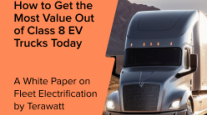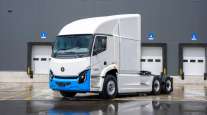China's Shenzhen Quietly Emerges as Megacity With Electric-Vehicle Focus
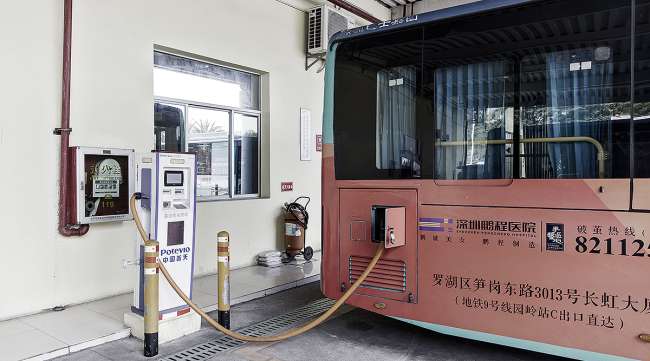
On a recent afternoon at a bus stop in the Nanshan business district in Shenzhen, China, the air was filled with the sound of chirping birds in a nearby park. The street was quiet, with the exception of the occasional diesel truck chugging past — holdouts against a future that glided in with barely a sound: an electric bus.
A woman who had been browsing on her smartphone while she waited hadn’t noticed the bus creeping up to the stop. Not until the doors opened with a beep, beep, beep and a man barking boisterously into his phone stepped out did she spring into action and hop aboard. Passengers scanned in with their smartphones, paying through WeChat, the app developed by Tencent Holdings Ltd., the Chinese social media giant whose flashy 50-story headquarters could be seen from the bus stop.
Every megacity can trace its history in increments of rising decibels. For most of them, the turning point was the Industrial Revolution. But in Shenzhen—now packed with more than 20 million people and hundreds of factories turning out high-tech hardware — the quiet age is only four decades in the past. Back then, China’s answer to Silicon Valley still was a collection of calm fishing villages just across the river from bustling Hong Kong.
But in 1980, Deng Xiaoping declared Shenzhen to be China’s first special economic zone. The unending wail of urban sound descended almost at once: cars, highways, delivery trucks, sirens, buses, factories, power plants, shipping facilities, trains and innumerable motorbikes. The newborn metropolis swiftly took its place among its global peers in making a never-ending racket.
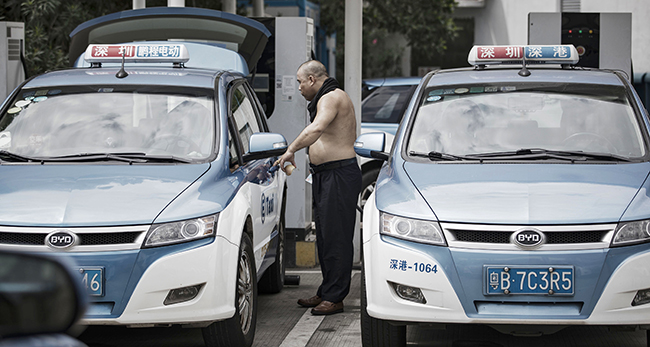
A driver stands next to a BYD electric taxi while it is charged at the company's charging station in Shenzhen, China. (Qilai Shen/Bloomberg News)
The master plan created 14 local industrial clusters, distributing the risk of the government’s experiment. The first factory workers relied on about 300 fishing and farming villages for basics such as potable water and food. The result is that modern Shenzhen is multicentered, with clusters of walkable space, according to Juan Du, an architecture professor at the University of Hong Kong who studied the urban transformation. The city experimented with infrastructure: highways, bus corridors and a subway that now has one-third the number of stops as New York’s (at one-tenth the age). Bullet trains, ferries and a new airport connect it to the world.
Because of how the city developed, with skyscrapers filling in the spaces among rural farm communities, about half the city’s residents are urban villagers who don’t necessarily require their own cars. The new Shenzhen has a mix of electric buses, electric bikes and scooters, electric taxis, and even electric dump trucks. Although the city arrived late to urban noise, the shift to EVs that China has been pushing more than any other country has put Shenzhen at the leading edge of something unprecedented: the quieter city.
If Shenzhen is at the forefront of metropolis-scale replacement of the combustion engine, then BYD Co. is the new Ford of China’s electrified-motor city. The electric-vehicle maker, backed by big Chinese subsidies and a $232 million investment from Warren Buffett in 2008, has eclipsed Tesla Inc. as the leading maker of plug-in EVs. BYD almost singlehandedly electrified Shenzhen’s fleet of 16,000 buses and is now at work on the full-scale replacement of the city’s taxis and trucks.
At the company’s Shenzhen headquarters, more than 37,000 employees make parts for electric cars, buses and taxis. Most will be sold in China as part of the government’s master plan to become the world’s industrial powerhouse of what Beijing calls “new-energy vehicles.”
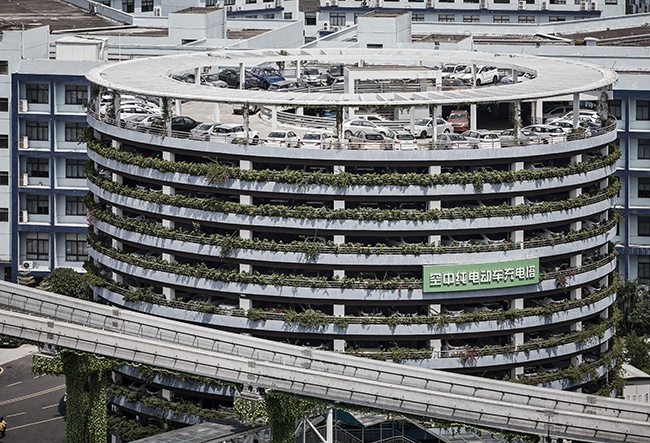
A charging parking lot tower stands at the BYD headquarters in Shenzhen, China. (Qilai Shen/Bloomberg News)
BYD’s founder, billionaire Wang Chuanfu, envisions China’s fleet, now at 300 million registered vehicles, entirely electrified by 2030. That’s more ambitious than the goals set by policymakers in Beijing, who are shooting for 20% electrification by 2025. But Wang insists. “It will happen earlier than expected,” he told reporters in Shenzhen last year.
China’s push to go fully electric would give BYD a strong domestic foundation for its ultimate ambition to become a global brand. To that end, Wang hired actor and climate champion Leonardo DiCaprio in 2017 as a brand ambassador and began exporting its vehicles to the United States. BYD has inked deals to supply electric buses to Facebook Inc.’s sprawling headquarters in Menlo Park, Calif., the transit authority in Long Beach, Calif., and the campuses of Stanford University and the UCLA. The most recent victory came in August, when BYD won a bid to supply all Georgia government entities with EVs.
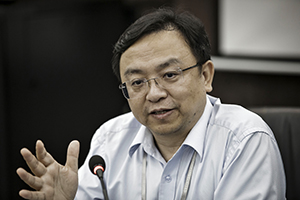
Wang by Qilai Shen/Bloomberg News
The company is using the immense financial backing at home to its advantage. A $9 billion credit line from China Development Bank, for example, is helping BYD place electric monorails in Brazil, Egypt and the Philippines. But the crutch of government funding, which has supported the company’s expansion, may not be around forever. Grants that once covered half the 1 million yuan ($147,000) it takes to build an electric bus in 2015 now only cover a third of the cost. Shrinking subsidies are a serious threat for a company with big research and development costs.
One of the biggest bottlenecks for BYD’s success at home and abroad is finding the space for charging stations. The company has had to get creative in Shenzhen, slapping solar panels on top of a parking garage to create its first taxi-charging station. As Shenzhen’s housing prices skyrocket to rival Hong Kong’s, real estate for charging stations isn’t easy to find, and then they have to be fitted to the grid, BYD spokesman Xiao Haiping said.
At Shenzhen Eastern Bus Co., one of BYD’s three bus-fleet partners, the monthly electricity bill of 17 million yuan is one-third of what its diesel bill used to be. The company has 15,000 employees and 5,800 buses, which use seven charging stations. Most of the buses are charged at night, when electricity is cheaper, though they sometimes have to top off in the afternoon. Each bus takes about three hours for a full charge and has a range of 250 kilometers (155 miles).
At one of the charging stations on the outskirts of Shenzhen, the mechanics have strikingly clean hands, because they haven’t been handling oil-covered parts all day. Workers fiddling with the new technology on a daily basis came up with breakthroughs, some of which are on display at the facility’s “innovation room.” The only noise comes from a fan and a giant vacuum keeping the motors clear of dust.
Another force pushing Chinese cities toward an electric — and therefore quieter — future is the government’s draconian antipollution measures. They began in 2013 with a set of prohibitions called the Air Pollution Action Plan, which capped coal use, banned additional coal-burning capacity and set limits on fine particulate matter for key regions. A new plan, published in July, set a target of 2 million electric-car sales per year by 2020. Shenzhen put in place high fees for gas-vehicle licenses while offering free parking and tax incentives to encourage the purchase of electric vehicles. The city also has mandated that all new trucks be electric and that 20,000 diesel trucks be scrapped. Ride-sharing services must now use EV fleets, too.
“Electric cars can definitely reduce the noise,” said Tao Liu, chairman of Clocell Corp., a company that created a sound map of Shenzhen’s busy Futian District to help the government tackle noise pollution.
Perhaps the most significant moment in Shenzhen’s shift toward quiet came in 2003, when the city began a ban on gas-powered motorcycles. In the ban’s wake came vastly popular electric bikes, which riders could use without a license to get around most of the city. But being so quiet, the bikes became a menace, with riders flouting traffic laws and clobbering pedestrians. City authorities eventually banned them, with some half-million ending up in a massive dump. Even after the enforcement sweep, many e-bike riders have finagled their way back onto the roads.
Shenzhen also offers evidence that urban cleanup has its limits. The Mawan coal plant, albeit one of the first in China to use seawater to reduce sulfur dioxide emissions, is inconveniently located in an up-and-coming neighborhood near electric-bus stops. It’s a reminder that China’s electricity is still two-thirds coal-powered. All those e-vehicles still end up plugged into a dirty, noisy grid.
Shenzhen Mayor Chen Rugui, a former Communist Party chief in Zhongshan, also is honing in on gridlock, a major source of noise pollution, with the use of heavy surveillance that seems more like an Orwellian spy state than an urban utopia. The city’s traffic police bureau is working with telecommunications giant Huawei Technologies Co. to use big data, facial recognition and video sensors to manage congestion and accidents. Shanghai-based startup KeyGo Technologies uses an “acoustic camera” system to zero in on honking cars, so police can analyze whether the noise pollution deserves a fine.
Tao, whose company sells noise insulation to wealthy clients, expects EVs will bring calm but not pure noiselessness. Electrics do make some sound, especially when they go fast. Even if electric vehicles are quieter on average, Tao said, the hissing whir they make at high speeds may not be much better than the vroom of a combustion engine. At higher speeds, the low-pitched whistle is caused by the car cutting through the air, not the motor. So, Tao said, luxury EVs actually may contribute to Shenzhen’s next noise problem: rich kids drag racing in the wee hours.
“They’ll drive out at night, and you know the sound,” Tao said. “BroooOOOOoooom!”


